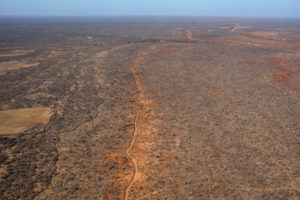BAIDOA, Somalia — First the trees dried up and cracked apart.
Then the goats keeled over.
Then the water in the village well began to disappear, turning cloudy, then red, then slime-green, but the villagers kept drinking it. That was all they had.

Now on a hot, flat, stony plateau outside Baidoa, thousands of people pack into destitute camps, many clutching their stomachs, some defecating in the open, others already dead from a cholera epidemic.
“Even if you can get food, there is no water,” said one mother, Sangabo Moalin, who held her head with a left hand as thin as a leaf and spoke of her body “burning.”
Another famine is about to tighten its grip on Somalia. And it’s not the only crisis that aid agencies are scrambling to address. For the first time since anyone can remember, there is a very real possibility of four famines — in Somalia, South Sudan, Nigeria and Yemen — breaking out at once, endangering more than 20 million lives.
International aid officials say it’s the biggest humanitarian disaster since World War II. And they are determined not to repeat the mistakes of the past.
One powerful lesson from the last famine in Somalia, just six years ago, was that famines were not simply about food. They are about something even more elemental: water. If there was any doubt, the recent news from Somalia or Nigeria should erase it.
Once again, a lack of clean water and proper hygiene is setting off an outbreak of killer diseases in displaced persons camps. So the race is on to dig more latrines, get swimming-pool quantities of clean water into the camps, and pass out more soap, more water-treatment tablets and more plastic buckets — decidedly low-tech supplies that could save many lives.
“We underestimated the role of water and its contribution to mortality in the last famine,” said Ann Thomas, a water, sanitation and hygiene specialist for Unicef. “It gets overshadowed by the food.”
The famines are coming as a drought sweeps across Africa and several different wars seal off extremely needy areas. United Nations officials say they need a huge infusion of cash to respond. So far, they are not just millions of dollars short, but billions.
At the same time, President Trump is urging Congress to cut foreign aid and assistance to the United Nations, which aid officials fear could multiply the deaths. The United States traditionally provides more disaster relief than anyone else.
“The international humanitarian system is at its breaking point,” said Dominic MacSorley, chief executive of Concern Worldwide, a large private aid group.
Aid officials say all the needed food and water exist on this planet in staggering abundance — even within these hard-hit countries. But armed conflict that is often created by personal rivalries between a few men turns life upside down for millions, destroying markets and making the price of necessities go berserk.
In some areas of central Somalia, a 20-liter jerry can of water, about five and a quarter gallons, used to cost 4 cents. In recent weeks, that price has shot up to 42 cents. That may not sound like a lot. But when you make less than a dollar a day and your flock of animals — your family’s pride and wealth — has been reduced to a stack of bleached bones and your farm to dust, you may not have 42 cents.
“There is no such thing as free water,” said Isaac Nur Abdi, a nomad, who sat in the dusky gloom of a cholera treatment center in Baidoa this month. He fanned his elderly mother, whose cavernous eye sockets and protruding cheekbones bore the telltale signature of famine.
Scenes like this are unfolding across the region. In Yemen, relentless aerial bombings by Saudi Arabia and a trade blockade have mutilated the economy, sending food prices spiraling and pushing hundreds of thousands of children to the brink of starvation.
In northeastern Nigeria, thousands of displaced people have become sick from diseases spread by dirty water and poor hygiene as the battle grinds on between Islamist militants and the Nigerian military, which, when it comes to protecting the vulnerable, does not have the most stellar record. The Nigerian Air Force bombed a displaced persons camp in January, killing scores, saying it was an accident.
In South Sudan, both rebel forces and government soldiers are intentionally blocking emergency food and hijacking food trucks, aid officials say. Entire communities are marooned in malarial swamps trying to survive off barely chewable lotus plants and worm-infested swamp water.
While the other countries are technically on the brink of famine, the United Nations has already declared parts of South Sudan a famine zone.
Read more: Drought and War Heighten Threat of Not Just 1 Famine, but 4
Source: nytimes


